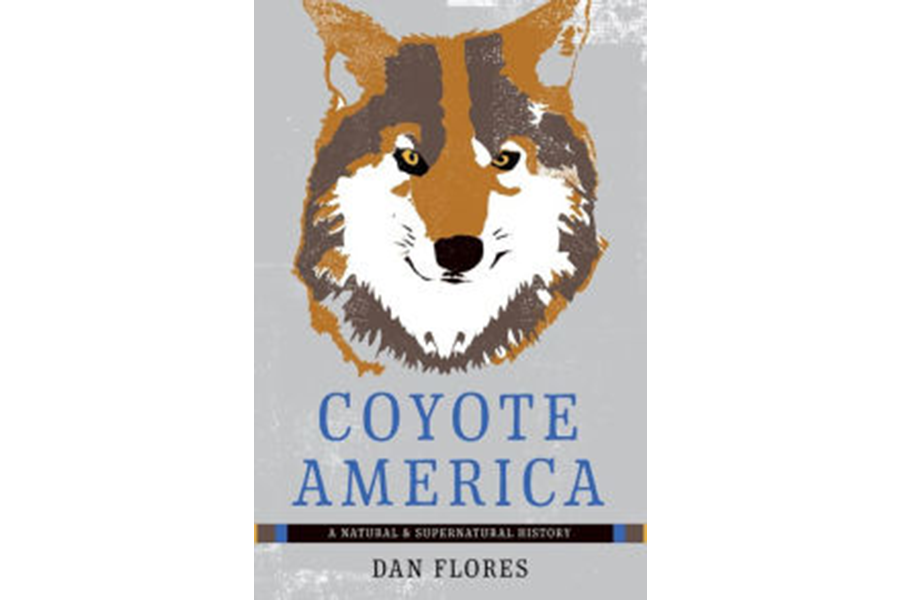'Coyote America' takes a fresh look at a well known enemy
Loading...
Author Dan Flores knows that in the popular mythology of the American West, coyotes are those “ever-trotting, golden-eyed creatures of vertical red canyons and sere deserts,” but he opens his compassionate and captivating new book, Coyote America, very pointedly in a different setting altogether: suburban Louisiana, where he had a boyhood encounter with a pair of coyotes while taking in the morning newspaper.
That ubiquity in the haunts of humans is the theme running throughout the book. For the thousands of years that humans have lived in North America, coyotes have been seeking out cities and settlements in order to make their homes on the peripheries. Coyotes prowled the side-streets of Aztec cities like Tenochtitlan 600 years ago much as they prowl the side-streets of Cape Cod today. Their yipping, singing cries filled the nighttime for 19th-century prairie settlers just as they do for Boston residents living near the Arnold Arboretum or Mount Auburn Cemetery. “Close encounters with coyotes,” writes Flores, “have now become the country's most common large-wildlife experience.”
"Coyote America" is a history of the coyote-mankind encounter, which has been one of bloodshed and slaughter for most of its length. Mark Twain may have famously characterized the species Canis latrans as “a long, slim, sick and sorry-looking skeleton ... a living, breathing allegory of Want,” but humans were hunting, trapping, and attempting to exterminate coyotes long before Twain was born, and their efforts have persisted into the present day: In the United States alone, the ironically named Wildlife Services still kill some 80,000 coyotes every year. Many of Flores's descriptions of the details of these extermination campaigns are not for the faint of heart, and it is depressing to think that even these levels of inventive savagery were eclipsed by the American attempt to exterminate the coyote's distant cousin, the wolf – a campaign covered in gruesome detail in Jon Coleman's aptly-titled 2004 book "Vicious."
Bounty offers and open killing seasons have been common throughout American history, Flores writes, and the rhetoric involved was often hysterical. “Farmers, ranchers, writers for any manner of national publication, and eventually employees of almost every state and federal agency involved with wild predators seemed almost to vie with one another in labeling the coyote a vile species of vermin that should not be allowed to breathe up good air.”
Flores goes on to point out, with the gentle understatement that underpins much of "Coyote America," that at a distance, “the hatred seems hard to square with anything rational.”
And yet, as the coyote's abundance in American folklore and indigenous mythology attests, all such efforts have been in vain. Coyotes are notoriously smart and adaptable – much like the humans who have for so long tried to wipe them out (Flores points out that both Homo sapiens andCanis latrans are both young enough species to make this almost a kind of sibling rivalry) – and even the most aggressive “management” programs tend to fail. Reducing the total population of coyotes in a given area by 70 percent, Flores openly enthuses, “ – not just once but year after year after year – produced no appreciable effect on coyote population density!”
Intriguingly, coyotes owe a big part of the success of their city-infiltration to the attempts of those cities to address the problem of roving canines. For most of American history, coyotes were prevented from roaming streets and playgrounds and city dumps by another distant cousin, Canis familiaris. But in the late 19th- and early 20th-century, urban centers of all sizes began toughening their stance on stray dogs, and as city pounds and leash laws were strengthened and stray dogs began to disappear, coyotes, who were always waiting on the outskirts, watching for their chances, began slipping back in.
Where strolling lovebirds in the Central Park of Edith Wharton's days sometimes distastefully mentioned roving stray dogs, their 21st-century counterparts are far more likely to see roving coyotes at twilight.
The good news suffusing Flores's book is that the reaction of such onlookers would likely take a different tone today than in the past. When Hope Ryden wrote her coyote book, "God's Dog," back in 1975, the pitch of righteous indignation she reached about the US Department of Agriculture's federally sanctioned war on coyotes (“Fifty-five million years of Canis latrans evolution they would snuff out by any obscene means at their command,” she wrote) was amplified by a sense of public disengagement.
But despite the fact that American ranchers continue their war on the coyote (a war Flores assures us is hopeless in any case), in most other segments of the population, the increasing appearance of coyotes in the daily urban experience is a welcome thing, bringing a touch of the exotic in a very familiar form. Flores can end his book on a note of hope that's very rare in 21st-century natural histories of any species, including our own. In "Coyote America," he warns us, “coexistence with coyotes is an essential lesson.” His exuberant book is the lesson plan.








